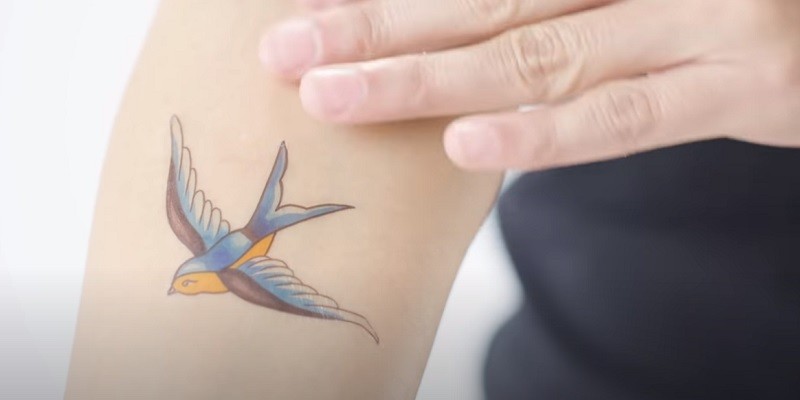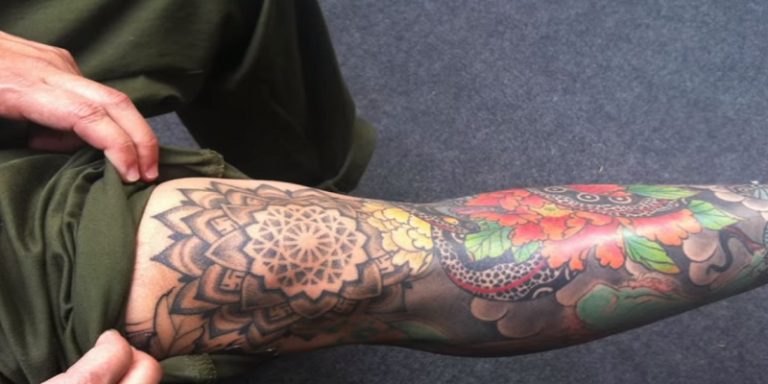Can Teachers Have Tattoos?

Last Updated on June 18, 2025 by Jaclyn A. Neeley
Teachers can have tattoos as there are no specific regulations prohibiting them from having body ink. Teachers are an essential component of the educational system, responsible for shaping young minds and imparting knowledge.
However, they are not exempt from personal expression through body art, such as tattoos. While some professions may have strict guidelines regarding tattoos, there is no universal restriction on teachers having tattoos. The acceptance of tattoos among teachers varies across educational institutions and regions.
Factors like the size, visibility, and nature of the tattoo may influence how it is perceived by administrators, colleagues, and parents. Consequently, teachers with tattoos might be required to cover them up or ensure they are not offensive or disruptive in an academic setting. We will explore the topic of teachers and tattoos, examining the general perception, possible limitations, and guidelines for educators with body ink.
Perceptions And Stigmas
Teachers with tattoos challenge traditional perceptions and stigmas in the classroom. Breaking stereotypes, they demonstrate that personal body art does not impede their professionalism or ability to educate.
Societal Attitudes Towards Tattoos
In modern society, attitudes towards tattoos have evolved significantly. Once considered rebellious or associated with criminal activities, tattoos are now widely accepted as a form of self-expression. People from different backgrounds and professions have embraced tattoos as a way to showcase their personal beliefs, passions, and creativity. However, perceptions surrounding tattoos in the teaching profession may still be influenced by traditional and conservative viewpoints.
Impact Of Tattoos On Professional Image
The presence of tattoos on a teacher’s body can sometimes raise concerns among parents, school administrators, and even fellow colleagues. While it is important to recognize the rights of individuals to express themselves through body art, the impact of tattoos on a teacher’s professional image cannot be ignored.
When it comes to tattoo visibility, the opinions vary. Some argue that visible tattoos can distract students, create biases, or even generate stereotypes about the teacher’s character and ability to be a role model. On the other hand, proponents argue that tattoos do not affect an educator’s skills or dedication to their profession, asserting that a teacher should be judged solely based on their effectiveness in the classroom.
Moreover, an individual’s appearance, including their tattoos, should not overshadow their qualifications or passion for teaching. Ultimately, it is the teacher’s ability to connect with students, deliver engaging lessons, and create a positive learning environment that should be the determining factor.
While these debates continue, it is worth noting that attitudes towards tattoos are gradually shifting. Many schools and districts have revised their policies, adopting a more inclusive approach by relaxing restrictions on visible body art. This shift acknowledges that a person’s professionalism and dedication to their job cannot be solely determined by their physical appearance. Rather, it should be based on their competence, work ethic, and ability to inspire and educate students.
The perceptions and stigmas surrounding teachers with tattoos highlight the ongoing tension between personal expression and professional expectations. Although the impact of visible tattoos on a teacher’s professional image is still a matter of debate, it is clear that societal attitudes towards tattoos have become more accepting and open-minded. As the teaching profession continues to evolve, it is important to reevaluate and challenge any preconceived notions about tattoos, focusing instead on the qualities and abilities that make a great teacher.
Teacher’s Rights And Responsibilities
Schools have a responsibility to provide a safe and inclusive environment for students, and teachers play a crucial role in shaping this environment. As such, it’s essential to consider the rights and responsibilities of teachers, including whether they can have tattoos. Understanding the legal considerations and school policies around teacher tattoos is important for educators and administrators alike.
Legal Considerations
When it comes to teachers and tattoos, legal considerations can vary depending on the jurisdiction. Generally, teachers have the same legal rights as any other employee regarding their appearance, including tattoos. Throughout the years, courts have increasingly recognized tattoos as protected self-expression under the First Amendment.
However, it’s essential to recognize that there may be some limitations to this right. If a teacher’s tattoo is deemed offensive, discriminatory, or otherwise disruptive to the educational environment, the school may have legitimate grounds to address the issue. It’s crucial to strike a balance between individual rights and the school’s responsibility to create a safe and respectful atmosphere for students.
School Policies And Guidelines
Many schools have specific policies and guidelines regarding teacher appearance, including tattoos. These policies are often in place to ensure a professional and inclusive learning environment that considers the diverse backgrounds and beliefs of students and their families.
It’s important for teachers to familiarize themselves with their school’s tattoo policy, which may outline acceptable visibility, size, content, or placement of tattoos. Some schools may require teachers to cover their tattoos while in the classroom or participating in school-related activities, while others may allow visible tattoos as long as they do not depict inappropriate or offensive content.
By adhering to school policies, teachers demonstrate their commitment to maintaining an atmosphere of respect and professionalism while also accommodating the diverse needs of their students and families.
Building Rapport With Students
Building rapport with students is a crucial aspect of being an effective teacher. Teachers with tattoos can actually use their body art as a tool to connect and relate to their students. By promoting open-mindedness and acceptance, they can create an inclusive and welcoming classroom environment. Here are two ways teachers with tattoos can build rapport with their students:
Connecting Through Shared Interests
One of the benefits of having tattoos is that they can serve as conversation starters. Teachers with tattoos often find that their students are curious about the meanings and stories behind their ink. This curiosity can lead to conversations about shared interests and hobbies. For example, if a teacher has a tattoo of a musical note, it may spark a conversation about music or a particular band. This common ground can help to break down barriers and create a connection between the teacher and student.
Example:
| Teacher: | I noticed you looking at my tattoo. Are you interested in music? |
| Student: | Yes, I love playing the guitar! |
| Teacher: | That’s great! I have this tattoo because music is a big part of my life too. |
Promoting Open-mindedness And Acceptance
Having visible tattoos can also be a way for teachers to promote open-mindedness and acceptance in the classroom. Teachers with tattoos can serve as role models for their students by demonstrating that people with tattoos can be intelligent, compassionate, and successful. This can help to break down stereotypes and challenge any preconceived notions that students may have about people with tattoos. By accepting and embracing their own body art, teachers can encourage their students to be accepting of others, regardless of their appearance.
Example:
- Teacher: I have tattoos because they reflect my personal style and interests. Tattoos do not define a person’s character or abilities.
- Student: But aren’t people with tattoos rebellious and unprofessional?
- Teacher: Not at all! Many successful people have tattoos. It’s important to judge someone based on their actions and qualities, rather than their appearance.
- Student: Wow, I never thought about it that way. I guess I shouldn’t judge people based on their tattoos.
Building rapport with students is essential for creating a positive and engaging learning environment. Teachers with tattoos can use their body art to connect with their students through shared interests and promote open-mindedness and acceptance in the classroom. By embracing their tattoos and using them as conversation starters, these teachers can build stronger relationships with their students and foster a sense of inclusivity and understanding.
Role Modeling And Influence
As educators, teachers have a significant role in shaping the minds and characters of their students. They serve as role models, displaying values, and influencing their pupils’ perspectives on various aspects of life. This influence extends beyond academics and encompasses values, diversity, critical thinking, and other crucial life skills. Let’s explore how teachers with tattoos can positively impact their students’ development in these areas.
Teaching Values And Diversity
When it comes to teaching values and diversity, teachers with tattoos can be powerful agents of change. Their visible tattoos can spark conversations about acceptance, inclusivity, and respecting differences. By embracing their own identities and expressing their values through tattoos, they create an environment that promotes acceptance and encourages students to explore their own beliefs and values.
Teachers with tattoos can help students develop an understanding of the importance of respecting and appreciating diversity. They can explain their tattoos’ significance, connecting them to various cultures, histories, or causes. This exposure to different perspectives fosters empathy and cultivates an inclusive mindset in students. It encourages them to celebrate diversity and reject stereotypes in all aspects of their lives.
Developing Students’ Critical Thinking
Teachers play a crucial role in developing their students’ critical thinking skills. By encouraging students to question, analyze, and think independently, teachers equip them with the tools necessary for success in a rapidly changing world. Teachers with tattoos can provide an additional layer of inspiration for critical thinking.
When students see their teachers with tattoos, it prompts their curiosity. They may wonder about the stories behind the tattoos, the decisions that led to their creation, or the messages they convey. This natural curiosity creates opportunities for teachers to engage students in meaningful discussions and encourage them to think critically. They can ask questions like, “What do you think this tattoo might represent?” or “Why do you think the teacher chose to get this tattoo?”
This interaction not only stimulates critical thinking but also instills a sense of curiosity and open-mindedness in students. It teaches them to explore different perspectives, challenge assumptions, and seek understanding beyond surface-level observations.
Teachers with tattoos have a tremendous potential to positively impact their students’ development. Through their visible tattoos, they can model values and promote diversity, while also igniting critical thinking and curiosity. By embracing their tattoos, teachers demonstrate the importance of embracing and expressing one’s identity, fostering an inclusive and intellectually stimulating classroom environment.
Navigating Parental Concerns
Teachers with tattoos often stir up concerns among parents, but should it really matter? Despite parental worries, having tattoos doesn’t affect a teacher’s ability to educate and mentor students. Society’s perception of body art is evolving, and it’s important to judge teachers based on their knowledge and skills rather than their appearances.
Addressing Parent Expectations
When it comes to the topic of teachers having tattoos, it’s essential to understand and address the concerns of parents. Parental expectations play a significant role in the perception of teachers, and their concerns should be acknowledged and addressed with professionalism and empathy.
It’s important to start the conversation by reassuring parents that their child’s education and well-being are the top priorities. By addressing their concerns directly, teachers can establish an open and transparent line of communication, allowing parents to feel heard and understood.
One effective way to address parental expectations is by creating opportunities for dialogue and discussion. Hosting parent-teacher meetings or sending out regular newsletters can serve as platforms to address any concerns or questions parents may have regarding tattoos and their impact on the learning environment.
Communicating Professionalism
Teachers with tattoos can successfully communicate professionalism by focusing on their behavior and their commitment to their profession. By emphasizing their educational qualifications, experience, and dedication to student success, teachers can show parents that they are competent and reliable educators.
Appearance is only one aspect of professionalism. Teachers can emphasize their ability to create a positive and inclusive classroom environment, foster strong communication with both students and parents, and consistently deliver high-quality instruction.
Moreover, it’s important for teachers with tattoos to dress professionally, adhering to employee dress codes and guidelines. By dressing in a manner that is appropriate for the educational setting, teachers can visually demonstrate their commitment to professionalism.
Additionally, teachers can emphasize the positive impact their tattoos can have on students. Tattoos can serve as conversation starters, allowing teachers to share personal stories and experiences that can inspire and motivate students while building a stronger teacher-student relationship.
Navigating parental concerns about teachers having tattoos requires open and empathetic communication, addressing parent expectations, and highlighting professionalism. By creating opportunities for dialogue and emphasizing their dedication to student success, teachers can alleviate concerns and nurture a positive relationship with parents.
Frequently Asked Questions For Can Teachers Have Tattoos?
Can Teachers Have Visible Tattoos?
Yes, teachers can have visible tattoos as long as they align with school policies and are not offensive.
Do Tattoos Affect A Teacher’s Professionalism?
Tattoos do not inherently affect a teacher’s professionalism as long as they are not offensive or distracting to students.
Can Teachers With Tattoos Apply For Any Teaching Position?
Teachers with tattoos can apply for any teaching position, but some schools may have specific policies regarding visible tattoos.
Will Having Tattoos Affect A Teacher’s Job Opportunities?
Having tattoos may potentially affect job opportunities depending on the school’s policies and the preferences of hiring administrators.
Are There Certain Areas Where Teachers Should Avoid Getting Tattoos?
Teachers should consider avoiding tattoos in highly visible areas, such as the face and neck, to minimize potential distractions in the classroom.
Conclusion
The perception of teachers with tattoos has evolved over time. Nowadays, having tattoos does not automatically disqualify someone from being an effective educator. However, it is essential for teachers to consider the potential impact of their tattoos on their professional image and the school environment.
Ultimately, what matters most is a teacher’s competence, dedication, and ability to positively influence students’ lives. With this in mind, the decision to have tattoos as a teacher should be made carefully, taking into account individual circumstances and the specific school culture.






